Status Under construction Line length 9 mi (14 km) | System Metro Rail Operator(s) Metro (LACMTA) Termini Wilshire/Western station | |
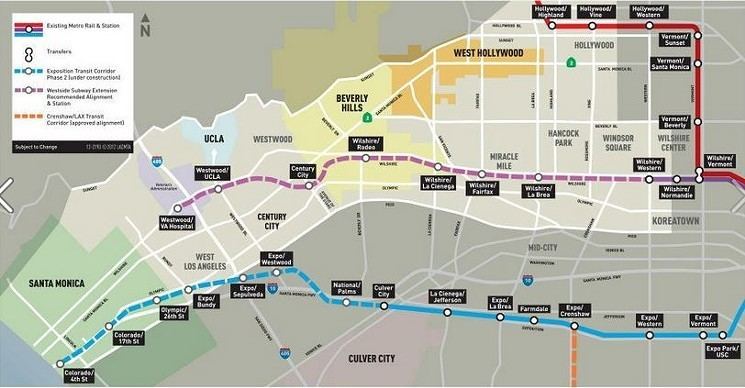 | ||
Planned opening 2023 (section 1)2024-2027 (section 2 & 3) Locale Similar Jurong Region MRT Line, Line 4 (Athens Metro), Chūō Shinkansen | ||
The Purple Line Extension, formerly known as the Westside Subway Extension and the Subway to the Sea, is a new heavy rail subway corridor in Los Angeles County, extending the Metro Purple Line from its current terminus at Wilshire/Western station in Los Angeles to the Westside region. Currently under construction, the corridor will become part of the Los Angeles County Metro rail system.
Contents
- Purple line extension construction uncovers ancient fossils feat paleontologist kim scott
- Overview
- Early concepts
- Opposition and halt of Wilshire branch
- New support and new project
- Initial alternatives analysis
- DEIR alternatives
- Selected alternative
- Opposition
- Project budget and planning
- Construction
- References
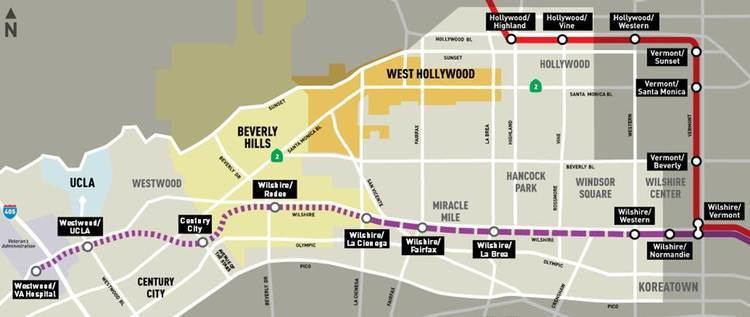
The project is being planned by Los Angeles County Metropolitan Transportation Authority (Metro). The subway has been given high priority by Metro in its long range plan, and funding for the project is included in Measure R and Measure M.
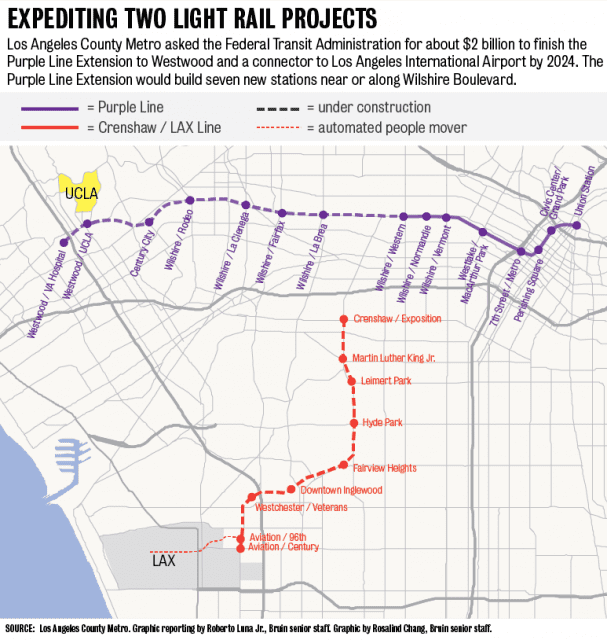
The draft environmental impact report was completed in September 2010; a locally preferred alternative was selected in October 2010. Metro released the final environmental impact report in 2012. The project was approved between Western Avenue and La Cienega Boulevard at the Metro Board of Directors meeting on April 26, 2012, with the western leg, including the controversial Century City location, deferred until the next board meeting. The location of the Century City station at Constellation Boulevard was approved by the Metro board of directors on May 24, 2012.
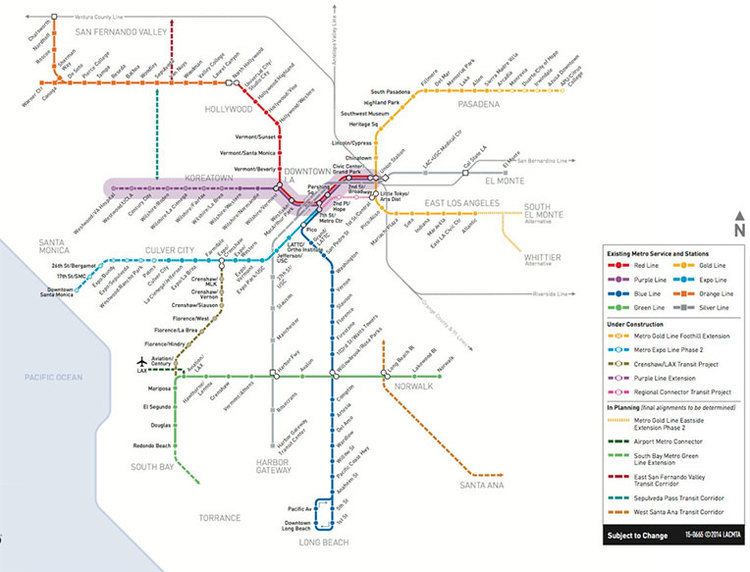
Construction on Section 1 of the Purple Line Extension, between the existing Wilshire/Western station and the planned Wilshire/La Cienega station, started on November 11, 2014.
Purple line extension construction uncovers ancient fossils feat paleontologist kim scott
Overview
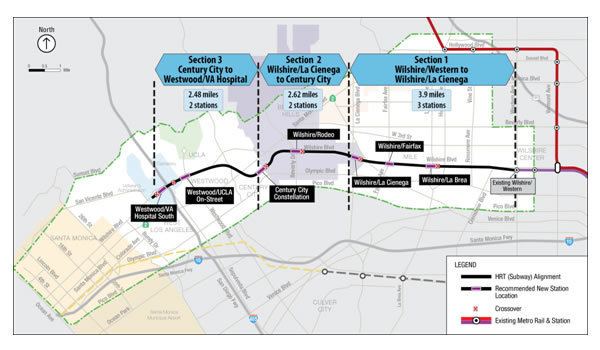
Current plans are to extend the line and necessary infrastructure west to Westwood. The following new subway stations will be built:
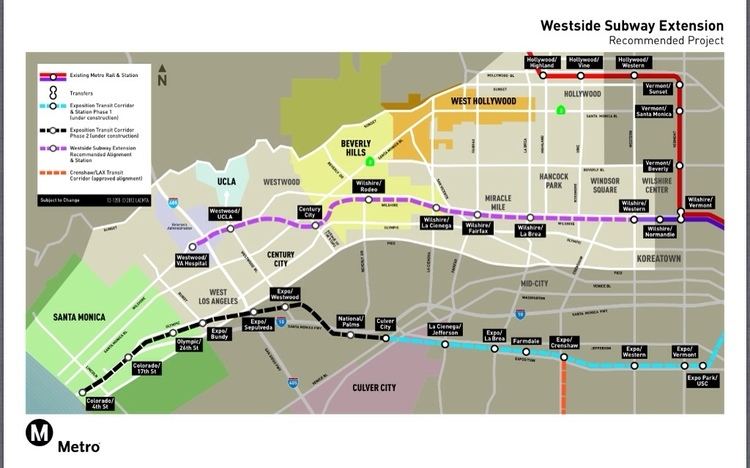
Funding is being sought to accelerate the project timeline; in particular, officials would like to open all stations by the start of the 2024 Summer Olympics, which Los Angeles is also competing to host.
Early concepts
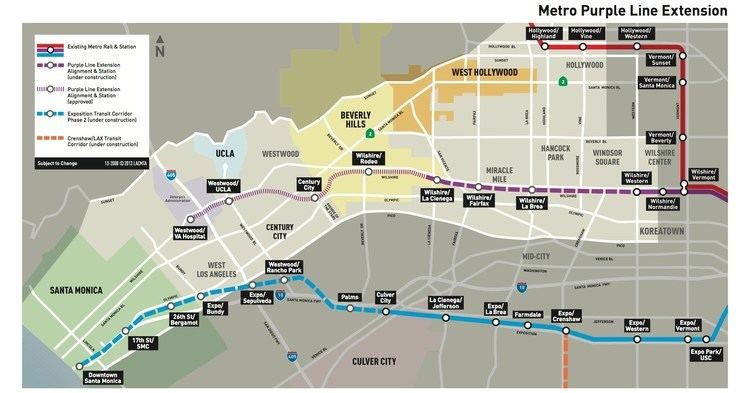
Early transit planners recognized the importance of Wilshire Boulevard as a spine and key boulevard in Los Angeles. Early plans for regional Metro Rail envisioned a rapid-transit route between Downtown and the Westside, with a branch going up Fairfax to Hollywood into the San Fernando Valley. In 1961, the "New Proposed Backbone Route Plan" described a subway along Wilshire Boulevard from Westwood to Downtown (and then elevated to El Monte). This project was never funded. Ballot initiatives in 1968 and 1974 to build a subway to West Los Angeles were rejected by voters, but in 1980 voters passed Proposition A, which created a half-cent county sales tax to fund rail construction. Ultimately, the Southern California Rapid Transit District (one of Metro's predecessors) planned a subway that would extend from Downtown Los Angeles to Fairfax Avenue, then up Fairfax to Hollywood and the Valley. Due to the "methane zone" (see below), that plan was modified, and Vermont Avenue was chosen for the north-south route instead of Fairfax.
Opposition and halt of Wilshire branch
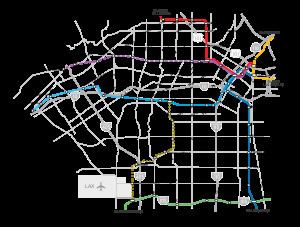
Several factors led to the eventual halt of plans to extend the subway west along Wilshire Boulevard. For decades, the route was mired in political and socioeconomic debate, with politicians giving vent to anti-subway sentiments and NIMBY isolationism. Some residents in the Fairfax District and affluent Hancock Park objected to the subway, fearing the type of people who would ride it to their neighborhood. The City of Beverly Hills also opposed the subway, as did two key legislators from the area: Congressman Henry Waxman and Los Angeles City Councilman Zev Yaroslavsky.
Following a methane explosion in 1985 at a Ross Dress for Less clothing store near Fairfax and Third Street, Congressman Waxman worked to legally designate a large part of Mid-Wilshire as a "methane zone." This zone stretched on either side of Wilshire Boulevard from Hancock Park to west of Fairfax (through areas of his district where subway opposition was strongest). Waxman was able to pass federal legislation banning all tunneling through this zone. Subsequently, any plans for a subway west of Western Avenue diverted the line south around the methane zone, using Crenshaw, Pico and San Vicente Boulevards. These plans never came to fruition, and to qualify for federal funding, the SCRTD instead started over and rerouted the subway north up Vermont Avenue, before traveling west under Hollywood Boulevard and then north toward the Valley. The Red Line was completed in 2000.
The Red Line project (which includes both of the present-day Red Line and Purple Line corridors) began in 1986. Soon after construction began, the project began to draw a considerable amount of bad press. Access to many local businesses was blocked for weeks, causing some small businesses to shut down. Disagreements arose between Metro and Tutor-Saliba (general contractor on the project) over tens of millions of dollars in cost overruns. A sinkhole in Hollywood seemed to symbolize the disastrous nature of the subway project. As a result, in 1998 voters approved a measure that was sponsored by County Supervisor Yaroslavsky that completely banned use of Proposition A and Prop C sales tax funds for any subway tunneling in the county. This effectively ended any chance of a Westside Subway in the foreseeable future.
The segment of the Red Line project (since renamed the Purple Line) to Wilshire/Western was completed and began service in 1996. To date, Wilshire/Western is the western terminus of the Purple Line.
New support and new project
In 2000, an urban art group known as Heavy Trash placed signs advertising a fictional "Aqua Line". The signs, with the text "Coming Soon", showed a subway route extending along Wilshire to the ocean, with ten station stops. Although the campaign was a hoax, it demonstrated newfound support and revealed the frustrations surrounding the lack of a subway connecting Santa Monica and the Westside with Downtown Los Angeles. The name "Aqua Line" was later repurposed as the proposed name for the Expo Line.
During the 2000s, support for the subway began to materialize, largely due to the massive impact of traffic on Wilshire Boulevard and throughout the region. The Metro Rapid bus line that currently operates along Wilshire Blvd. runs at capacity. In 2005, Los Angeles voters elected Antonio Villaraigosa mayor of Los Angeles. In his campaign and after the election, Villaraigosa declared an extension of a subway line to Santa Monica a major priority, offering visionary slogans such as "subway to the sea", "the most utilized subway in the nation, maybe the world," and "the most cost-effective public-transportation project in America." As mayor, Villaraigosa served several one-year-long terms as Metro Board chairman.
In December 2005, Congressman Henry Waxman, who had sponsored the "methane zone" tunneling ban twenty years earlier, championed the reversal of his own legislation, upon a committee's assertion that tunneling through the methane zone was now safe. To make this happen, Waxman introduced new congressional legislation (H.R. 4653) to overturn the ban.
In July 2006, the Metro board approved staff and funding to initiate a Major Investment Study (MIS) to study the corridor west of Western Avenue for a possible subway extension. In the following month, the Metro Board voted to designate the Wilshire branch of the Red Line, between Union Station and Wilshire/Western Station, as the Purple Line.
With a new name and a new study initiated, the Purple Line extension began to receive public support from several organizations. In 2006, the Westside Cities Council of Governments endorsed the extension. In September 2006, both Cedars-Sinai Medical Center and UCLA joined the Council's Mass Transit Committee to advocate for the subway extension. In 2007, the Beverly Hills City Council endorsed a Wilshire alignment that includes one station at the corner of Wilshire and La Cienega boulevards and another on Wilshire Boulevard between Beverly Drive and Rodeo Drive.
On June 28, 2007, the Metro board approved a $3.6 million contract with Parsons Brinckerhoff to provide an Alternatives Analysis (AA), an assessment of tunnel feasibility, and conceptual engineering with options for future preliminary engineering and environmental clearance for this extension.
Henry Waxman's legislation to lift the ban on tunneling through the "methane zone" finally became law in December 2007, as part of the 2008 omnibus spending bill. The passage of this long-awaited legislation allowed, for the first time in two decades, the planning and building of a westward extension of the subway.
In 2009, the Wilshire Subway Extension was included in Metro's Long Range Transportation Plan, and environmental studies were begun.
Initial alternatives analysis
During the alternatives analysis, many alternatives were considered. These included different alignments, as well as several modes of transit (heavy rail, light rail, bus rapid transit and monorail). Most alignments were variations/combinations of two basic alignments: the "Wilshire alignment" and the "West Hollywood alignment".
Other alignments studied involved various deviations from Wilshire Boulevard, to allow service to destinations such as Beverly Center, Cedars-Sinai Medical Center, and Farmers Market.
The Alternatives Analysis recommended further study on four alternatives: "No Build", TSM (Transportation Systems Management), the Wilshire Alternative, and a combination Wilshire/West Hollywood Alternative. Both build alternatives use heavy rail (HRT) as its transit mode, primarily because this would allow interconnection to the existing Metro Rail subway system. All proposed alignments involving other transit modes (monorail, LRT, and BRT) were eliminated.
DEIR alternatives
The five alternatives considered in the Draft Environmental Impact Report are:
Alternatives 3 and 5 are the build alternatives carried over from the alternatives analysis (AA). In addition, three new alternatives (Alternatives 1, 2, and 4) were added. These new alternatives are variations of the two AA-recommended alternatives which all stop short of Santa Monica. They were added to reflect the realities of limited available funds, as well as the priorities in Metro's Long Range Transportation Plan (LRTP).
The following table shows all potential metro stations, and the alternatives for which they apply:
In addition to the five build alternatives, the DEIR identified six sets of options:
Selected alternative
In September 2010, Metro published the draft environmental impact statement for the project. The report made no specific recommendation among the five alternatives. However, Metro staff did signal that only Alternatives 1 and 2 would be serious candidates for the Locally Preferred Alternative, since only those two alternatives match the project scope defined in Measure R and Metro's Long Range Transportation Plan (LRTP).
In October 2010, Metro staff recommended continuing study on Alternative 2. Staff also recommended:
In eliminating the West Hollywood Connection Structure, Metro staff eliminated the future possibility of a West Hollywood line as a heavy-rail branch of the Wilshire Subway, as described in Alternatives 4 and 5. Staff cited the $135 million cost, as well as lower than expected performance and cost-effectiveness. However, staff left open the possibility of other alternatives in the future which would not require a connection structure such as light rail, with a possible future extension south of Wilshire on San Vicente Boulevard, connecting to a future Crenshaw Line that would run north of Exposition Boulevard.
At the Metro Board meeting in late October 2010, the Metro Board certified the DEIR and accepted the staff recommendation as the Locally Preferred Alternative (LPA). Due to protests from Beverly Hills residents and local officials, the Metro Board approved an amendment requesting detailed study and comparison of the two Century City station options in the FEIR.
A Metro presentation dated October 29, 2013, shows the route to the Westwood Veteran's Administration Medical Center being approved, and the Phase I segment to La Cienega being under pre-construction through 2014 when full construction is scheduled to begin. This presentation also shows construction methods and timeline.
Opposition
During the planning and environmental review process, the Beverly Hills Unified School District and the city of Beverly Hills objected to the placement of the subway tunnel underneath Beverly Hills High School between the Wilshire/Rodeo and Century City stations. Metro chose a route placing the Century City station at Constellation Boulevard instead of Santa Monica Boulevard, due to lower ridership and an earthquake fault zone in the latter area. The school district claimed that Metro did not properly study the route to the Constellation Boulevard station, which it says could pose a safety risk to students. The school district and city filed a lawsuit in July 2012 against Metro. In April 2014, Los Angeles County Superior Court Judge John A. Torribio ruled that Metro had properly conducted environmental studies under the California Environmental Quality Act and a transit hearing under the requirements of the Public Utilities Code. The school district and city appealed the decision to the California Court of Appeal. The Court of Appeal affirmed the ruling by the lower court in favor of Metro.
Project budget and planning
Voter-approved Measure R assumes a project to Westwood, having a cost of $4.2 billion (2008 dollars). Measure R sales tax revenues will provide up to $4.074 billion toward the cost; however, it is expected that the project will receive close to half of its funding from Federal New Starts funds.
The selected alternative to Westwood/VA was estimated to cost $4.358 billion, which is over the Measure R budget. However, the LPA could cost less than this, since it excludes the Crenshaw station and West Hollywood connector structure.
Measure R funds became available in 2013, with expected project completion in 2035. The construction of the first 3.9-mile segment to La Cienega began in 2014. According to this schedule, the full extension would be ultimately be opened in three segments as follows:
However, efforts are underway to secure federal loans (through the 30/10 project) to accelerate the subway project, allowing it to be completed as a single project by 2024. President Obama's proposed 2015 budget included $115 million towards the first phase of the Purple Line extension and $100 million for the second phase. Citing Los Angeles's quest to host the 2024 Summer Olympics, Los Angeles County transportation officials are seeking to fast-track the project. With federal approval, Metro would follow an "extremely aggressive" schedule to finish the Purple Line subway extension and the Airport Metro Connector by 2024.
On January 4, 2017, the second phase of the Purple Line subway, which will connect Beverly Hills and Century City to Downtown Los Angeles by rail, received more than $1.6 billion in federal grants and loans. The federal money, in combination with $747 million in local sales tax revenue, gives the Metropolitan Transportation Authority enough funding to begin construction on the next phase of the long-awaited rail project along one of Los Angeles County’s most congested corridors.
Construction
In July 2014, a joint venture by Skanska, Traylor and J.F. Shea Co was selected by the Metro board, in a 9 to 3 vote, as the winner of the $1.6 billion contract for Section 1. Skanska was selected over a competing bid by Dragados that was $192 million lower because of Skanska's experience building other Los Angeles transportation projects, like the Expo Line and the Regional Connector. Groundbreaking occurred for Section 1 of the extension in November 2014. The 3.9-mile (6.3 km) segment will cost $2.8 billion: the federal government will provide a $1.25 billion New Starts grant and an $856 million infrastructure loan, with the remainder of the budget from Measure R funds. When complete, each station will have a ridership of around 62,000 on weekdays.
In January 2017, phase two of the project, which will extend trackage 2.6 miles (4.2 km) further to Century City, was awarded a $1.6 billion grant from the Federal Transit Administration, covering the majority of the $2.6 billion estimated cost of the project. On January 27, the Metro board awarded a $1.37 billion construction contract to a joint venture between Tutor Perini and O&G Industries, with construction scheduled to be completed by 2026.
